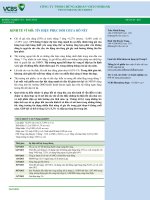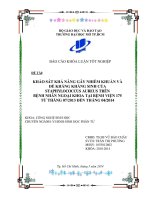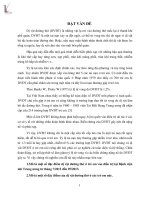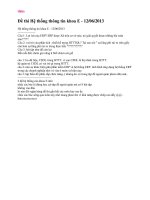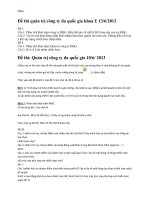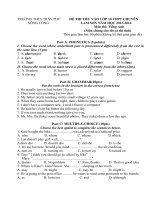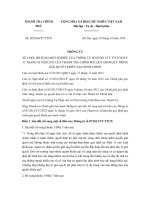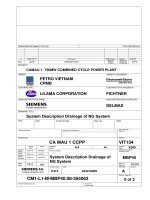E 502 07 (2013)
Bạn đang xem bản rút gọn của tài liệu. Xem và tải ngay bản đầy đủ của tài liệu tại đây (122.34 KB, 6 trang )
Designation: E502 − 07 (Reapproved 2013)
Standard Test Method for
Selection and Use of ASTM Standards for the Determination
of Flash Point of Chemicals by Closed Cup Methods1
This standard is issued under the fixed designation E502; the number immediately following the designation indicates the year of
original adoption or, in the case of revision, the year of last revision. A number in parentheses indicates the year of last reapproval. A
superscript epsilon (´) indicates an editorial change since the last revision or reapproval.
priate safety and health practices and determine the applicability of regulatory limitations prior to use. See also Section 8.
1. Scope
1.1 This test method covers the determination of the flash
point of liquid and solid chemical compounds flashing from
below − 10 to 370°C (16 to 700°F). The procedures and
apparatus in Test Methods D56, D93, D3278, D3828, and
D3941 are to be used. Modification to these procedures are
specified for tests on solids and viscous liquids. The significance of the results obtained is discussed along with possible
sources of error and factors that might cause interference.
2. Referenced Documents
2.1 ASTM Standards:2
D56 Test Method for Flash Point by Tag Closed Cup Tester
D92 Test Method for Flash and Fire Points by Cleveland
Open Cup Tester
D93 Test Methods for Flash Point by Pensky-Martens
Closed Cup Tester
D270 Methods of Sampling Petroleum and Petroleum Products (Withdrawn 1984)3
D1310 Test Method for Flash Point and Fire Point of Liquids
by Tag Open-Cup Apparatus
D3278 Test Methods for Flash Point of Liquids by Small
Scale Closed-Cup Apparatus
D3827 Test Method for Estimation of Solubility of Gases in
Petroleum and Other Organic Liquids
D3828 Test Methods for Flash Point by Small Scale Closed
Cup Tester
D3934 Test Method for Flash/No Flash Test—Equilibrium
Method by a Closed-Cup Apparatus
D3941 Test Method for Flash Point by the Equilibrium
Method With a Closed-Cup Apparatus
E681 Test Method for Concentration Limits of Flammability
of Chemicals (Vapors and Gases)
E1232 Test Method for Temperature Limit of Flammability
of Chemicals
1.2 Suggestions for adapting this procedure to mixtures of
chemicals are included (see Appendix X2).
1.3 This test method should be used to measure and describe
the properties of materials, products, or assemblies in response
to heat and flame under controlled laboratory conditions and
should not be used to describe or appraise the fire hazard or fire
risk of materials or assemblies under actual fire conditions.
However, results of this test method may be used as elements
of a fire risk assessment that take into account all of the factors
that are pertinent to an assessment of the fire hazard of a
particular end use.
1.4 Warning—Mercury has been designated by EPA and
many state agencies as a hazardous material that can cause
central nervous system, kidney and liver damage. Mercury, or
its vapor, may be hazardous to health and corrosive to
materials. Caution should be taken when handling mercury and
mercury containing products. See the applicable product Material Safety Data Sheet (MSDS) for details and EPA’s website
– - for additional information. Users should be aware that selling mercury and/or
mercury containing products into your state may be prohibited
by state law.
1.5 This standard does not purport to address all of the
safety concerns, if any, associated with its use. It is the
responsibility of the user of this standard to establish appro-
3. Terminology
3.1 Definitions:
3.1.1 flash point—the lowest temperature, corrected to a
pressure of 760 mm Hg (101.3 kPa) (1013 mbar) at which
application of an ignition source causes the vapors of a
specimen to ignite under specified conditions of test.
1
This test method is under jurisdiction of ASTM Committee E27 on Hazard
Potential of Chemicals and is the direct responsibility of Subcommittee E27.04 on
Flammability and Ignitability of Chemicals.
Current edition approved Oct. 1, 2013. Published October 2013. Originally
approved in 1984. Last previous edition approved in 2007 as E502 – 07ε1. DOI:
10.1520/E0502-07R13.
2
For referenced ASTM standards, visit the ASTM website, www.astm.org, or
contact ASTM Customer Service at For Annual Book of ASTM
Standards volume information, refer to the standard’s Document Summary page on
the ASTM website.
3
The last approved version of this historical standard is referenced on
www.astm.org.
Copyright © ASTM International, 100 Barr Harbor Drive, PO Box C700, West Conshohocken, PA 19428-2959. United States
1
E502 − 07 (2013)
4. Summary of Test Method
permit the use of small samples. If automatic testers are used, the user
must be certain that all instructions for calibration and operation are
followed to ensure that the results are equivalent to those obtained on the
ASTM standard equipment. For regulation purposes or in cases of dispute,
the flash point as determined on the manual tester shall be the accepted
value.
NOTE 2—ASTM thermometers 33C or 33F may be used in the Tag
Tester instead of those specified in Test Method D56 when conducting
tests at temperatures below − 10°C (14°F). Slight stem corrections may be
necessary and care should be taken to avoid freezing the mercury in the
thermometer by cooling below − 40°C (−40°F).
7.4 Shield, as described in Test Method D3941 or Test Method D1310.
4.1 The specimen is placed in a closed cup and in the small
scale method equilibrated at a test temperature, in the PenskyMartens Method heated at a controlled rate with stirring, and in
the Tag Method also heated at a controlled rate but without
stirring. A small flame is directed into the vapor space of each
cup at specified intervals, with simultaneous interruption of
stirring in the Pensky-Martens Method, to determine whether a
flash occurs or not. In Test Method D3941, the specimen is
heated at a slower rate than in the other controlled heating
methods, maintaining a small temperature differential between
bath and specimen.
8. Hazards
8.1 Toxicity of Chemical and Combustion Products:
8.1.1 Isolate or control operations on toxic or corrosive
materials to prevent exposure to any personnel.
8.1.2 Since flash point tests are conducted in still air, the use
of forced circulation for removal of toxic or nuisance fumes or
combustion products is restricted. However, a laboratory fume
hood equipped with an exhaust damper that can be completely
closed provides an ideal location for maintaining draft-free
conditions and provides the ability to readily exhaust dangerous vapors and combustion products when necessary.
8.1.3 Use respiratory and splash protective devices as appropriate with toxic or corrosive materials. In most cases,
approved cartridge respirators are adequate respiratory protection for the concentrations normally encountered in flash-point
testing. Certain toxic or unusual materials, however, may
require an air-supplied respirator and extreme cases may
require complete protective coverage such as an air-supplied
plastic suit. (Two examples of the latter type of material are
dimethyl sulfate and pure mercaptans.) Tests on these highly
toxic or obnoxious materials may also be conducted in completely isolated, closed systems, such as glove boxes. In this
case, procedures should ensure an uncontaminated air system
in the box, and should prevent a buildup of vapors from the
material under test.
5. Significance and Use
5.1 The flash point measures the response of the sample to
heat and flame under controlled laboratory conditions. It is
only one of a number of properties that must be considered in
assessing the overall flammability hazard of a material.
5.2 As a result of physical factors inherent in the apparatus
and procedure, the closed cup flash point does not necessarily
represent the minimum temperature at which a material can
evolve flammable vapors, and the absence of a flash point does
not guarantee nonflammability (see Appendix X1 and Appendix X2).
5.3 Flash point is used in shipping and safety regulations to
define flammable and combustible materials. Test Methods
D56, D93, and D3278 are specified as test methods for
determining the flash point of these materials.
5.4 If the process or handling conditions dictate the usage of
a flammable material at temperatures ranging upward from 5 to
10°C below the closed-cup flash point, then a flammable vapor
might be present above the liquid. In such cases, it may be
more appropriate to use the temperature limit of flammability
(as determined by Test Method E1232) instead of flash point.
5.5 Small scale methods involving equilibrium procedures
and only one flame pass per specimen are preferred.
8.2 Dry Ice Use:
8.2.1 Exercise care in the use of dry ice for sample and
apparatus cooling. Avoid contact with dry ice to prevent
frostbite. Glass bottles or vials of chemicals should not be
placed directly in dry ice or dry ice baths because of the
possibility of breakage due to thermal shock.
6. Interferences
6.1 Incorrect flash points can be obtained when testing
chemicals corrosive to the materials of construction of the cup.
(For example, certain amines and acid chlorides react with the
standard aluminum small scale cup causing erroneously low
flash points, perhaps due to hydrogen formation.) Cups employing alternative materials of construction, electroplating or
plastic coating can provide corrosion resistance. Results in
non-standard cups, particularly in non-equilibrium tests, may
differ slightly from those obtained in this test method.
8.3 Tests of Explosives and Propellants:
8.3.1 Flash tests should not be conducted on potential or
known explosive or propellant materials without complete
prior knowledge that burning will not result in propagation to
an explosive decomposition. Properly barricaded or remotely
operated automatic testers should be used if precise flash points
are needed.
7. Apparatus
8.4 Pyrophoric Materials:
8.4.1 Flash point apparatus is not applicable for the evaluation of pyrophoric materials and should not be used for this
purpose.
7.1 Tag Closed-Cup Tester, including thermometers, shall be
as shown in Test Methods D56 and D3941.
7.2 Penksy-Martens Closed-Cup Tester, including
thermometers, shall be as shown in Test Methods D93.
9. Preparation of Sample
7.3 Small scale Closed Tester, including thermometers, shall
be as shown in Test Methods D3278 or D3828.
9.1 Obtain samples representative of the batch under test.
Methods D270 can be used as a reference on sampling
techniques. With mixtures and with samples containing
NOTE 1—Some automatic flash point testers may save testing time and
2
E502 − 07 (2013)
impurities, take care to avoid the loss of volatile components
during sampling and handling for testing. When heating
viscous or solid materials for ease of pouring, samples must be
held at temperatures below, or as close as possible to, those
specified in the various test methods. Discard samples from
leaking or contaminated containers. Samples that are hygroscopic should not be exposed to moisture or moist air.
NOTE 7—With low temperature operation in the small scale methods,
equilibrium may be difficult to maintain due to heating by natural
convection. It, therefore, will be necessary to cool the cup and sample
below the anticipated flash point before specimen introduction (see Test
Methods D3278).
NOTE 8—In the Tag Method (Test Method D56), natural warming rates
sometimes exceed 1°C (2°F)/min. These rates can be reduced by insulating the outside of the bath container. A laboratory refrigerated circulator
may be used. One advantage of this system is that circulation of the
refrigerant bath with the system gradually warming up can serve as a
control on heating rate.
NOTE 9—With low-temperature operation in the Tag and Small scale
Methods, difficulties can be created by the formation of frost on the
surface of the tester. If precise flash points are needed in the temperature
range where frost conditions are encountered, tests can be conducted in a
dry box or a room of very low humidity. When ice formation on the lid and
cover parts cannot be avoided, the results will be unreliable. Sticking of
the slide due to ice formation can be minimized by carefully lubricating
the slide with a high vacuum silicone lubricant. Portions of the cover and
slide in the vicinity of the pilot flame and openings should be wiped free
of frost just prior to the initial flame insertion at 5°C (10°F) below the
flash point.
9.2 Samples should not be stored in plastic (polyethylene,
polypropylene, etc.) bottles, since volatile materials may diffuse through the walls of the bottle.
10. Preparation of Apparatus
10.1 Support the appropriate flash-point tester on a level,
steady work surface in a draft-free location. If a draft-free
location is not available, use a shield surrounding the tester on
three sides. The shield should be approximately 460 mm (18
in.) wide and 610 mm (24 in.) high.
NOTE 3—An area capable of being partially darkened is advantageous
since it aids in the detection of the relatively nonluminous flames
sometimes encountered in flash-point testing.
NOTE 4—Test Method D1310 gives a design for a draft shield suitable
for standard flash-point testers.
12.3 For
liquids with a viscosity equal to or greater than
−6
5.8 × 10 m2/s (5.8 cSt) at 38°C (100°F), or 9.5 × 10−6 m2/s
(9.5 cSt) at 25°C (77°F) and less than 15 × 10−3 m2/s (150 St)
at 25°C (77°F), and a flash point below 110°C (230°F), the
following procedure applies:
12.3.1 Use of Pensky-Martens Method (Test Methods D93)
or the small scale (Test Method D3278 or D3828) apparatus
and procedure.
11. Calibration
11.1 Check the condition and operation of the Tag, PenskyMartens and small scale testers as specified in Test Methods
D56, D93, D3278, or D3828, respectively.
12.4 For
liquids with a viscosity equal to or greater than
−6
5.8 × 10 m2/s (5.8 cSt) at 38°C (100°F) or 9.5 × 10−6 m2/s (9.5
cSt) at 25°C (77°F) and a flash point of 93°C (200°F) or above,
the following procedure applies:
12.4.1 Use the Pensky-Martens (Test Methods D93) and the
small scale (Test Method D3828) apparatus and procedure.
12. Procedure
12.1 Follow the procedures outlined in Test Methods D56 or
D3941 (Tag Closed Cup), D3278 or D3827 (Small scale
Closed Cup), and D93 (Pensky Martens Closed Cup), as is
necessary. Certain explanatory notes and procedure modifications not contained in the individual methods are given below.
Occasionally, particularly near the temperature of the actual
flash point, the application of the test flame will cause a halo or
test flame enlargement that should be ignored. In some cases
this test flame enlargement will not lead to a flash point on an
increase in temperature.
NOTE 10—Testing time may be reduced by initially heating samples at
higher rates than those specified in the test procedures, provided that the
specified heating rates are maintained in the temperature range in the
vicinity of the flash point. This is permissible provided that, during the fast
heat-up period, the highest temperature of the material (next to the cup
wall) never exceeds a temperature 11°C (20°F) below the flash point for
the Pensky-Martens method. Use extreme care when using fast heat-up in
the Pensky-Martens method since there are no provisions for bath
temperature measurement.
12.2 For liquids with a viscosity less than 5.8 × 10−6 m2/s
(5.8 cSt) at 38°C (100°F), or 9.5 × 10−6 m2/s (9.5 cSt) at 25°C
(77°F), observe the following:
12.5 −3For liquids with a viscosity equal to or greater than
15 × 10 m2/s (150 St at 25°C) (77°F) and solid materials that
flash while solid (Note 12), the following procedures apply:
12.5.1 Use the Small Scale Test Methods D3278 or Test
Method D3828 with the following modification:
12.5.1.1 Determine the flash point in the small scale unit
using a holding time of 6 min at the test temperature instead of
1 or 2 min normally employed.
12.5.1.2 Methods for loading the sample cup with highly
viscous liquids or solids are given in Test Methods D3278.
Solid materials can be loaded with a spoon.
NOTE 5—The first viscosity threshold point is stated either as
“5.8 × 10−6 m2/s (5.8 cSt) at 100°F (38°C)”, or as “5.5 × 10 −6 m2/s (5.5
cSt) at 40°C (104°F), in different flash point test standards. The choice is
indicative of only the unit system preferred by individual test standards. In
practice the two forms are considered equivalent.
12.2.1 If the flash point is below 93°C (200°F), use the
small scale (Test Method D3278 or D3828) or Tag (Test
Method D56) apparatus and procedures.
12.2.2 If the flash point is 93°C (200°F) or above, use the
small scale (Test Method D3828) or Pensky-Martens (Test
Methods D93) apparatus and procedures.
12.6 For equilibrium flash point method using the Tag
Closed Cup Tester, the following applies:
12.6.1−6 For liquids with a viscosity equal to or greater than
5.8 × 10 m2/s (5.8 cSt at 38°C (100°F) or 9.5 × 10−6 m2/s (9.5
cSt) at 25°C (77°F) and a flash point below 93°C (200°F), Test
Method D3941 may be used using the Tag Closed Cup.
NOTE 6—The electric heaters on some Tag Testers may be of insufficient capacity to maintain the specified heating rates when operating in the
upper ranges of this practice. Heat input can be increased slightly by using
a variable transformer to increase the voltage slightly on the heaters.
Insulation can be applied to the exterior of the bath to reduce heat losses.
3
E502 − 07 (2013)
TABLE 1 Repeatability
12.6.2 Test Method D3941 may also be used for the high
viscosity liquids and solids covered in 12.6 (Note 12). Observe
the temperature differences between bath and sample specified
in Test Method D3941. (The Tag tester is very inefficient for
testing these materials since large sample quantities and very
long testing times are required.)
Tester
Tag closed cup (Test Method
D56)
Tag closed cup (Test Method
D56)
Small scale (Test Method
D3278)
Viscosity at or below 5.8 ×
10 −6 m2/s (5.8 cSt) at
38°C (100°F)
Viscosity above 5.8 ×
10 −6 m2/s (5.8 cSt) at
38°C (100°F)
Small scale (Test Method
D3828)A
where: M = mean of two
results
Pensky-Martens (Test
Methods D93 A)
(Test Methods D93 B)
NOTE 11—With highly viscous materials it may be advantageous to fill
the tag closed cup vessel directly to a 50-mL line on the sample cup rather
than to use the graduated cylinder specified in Test Method D56.
Significant quantities of a viscous material may adhere to the walls of the
graduated cylinder when the transfer is made. Certain manufacturers
supply tag cups with a 50-mL line inscribed on the inner cup wall.
NOTE 12—The small scale procedure is the preferred method for solid
materials.
NOTE 13—The intent of the low heat rate specified in Test Method
D3941 is to ensure that misleading results are not obtained because of the
poor heat transfer characteristic of viscous materials. The test thermometer
should closely reflect the highest temperature to which the specimen
throughout the cup is being subjected. If a small temperature difference
between the temperature of the bath and the specimen is not maintained,
warm materials next to the cup walls will evolve vapors resulting in a
positive flash test while the test thermometer registers the temperature of
the cooler materials near the center of the cup.
Repeatability
1.1°C (2°F)
1.7°C (3°F)
1.7°C (3°F)
3.3°C (6°F)
20 to 70°C (68 to 0.5°C (1°F)
158°F)
above 70°C
0.022M (0.9°C)
(158°F)
104°C (220°F)
2°C (4°F)
and under
5.5°C (10°F))
above 104°C
5°C (9°F)
(220°F)
Viscous materialsB
A
Test Method D3828 is identical to British Institute of Petroleum Method IP303.
The above precision figures for this test method were taken from the British
round-robin tests.
B
Repeatability and reproducibility figures have not been determined for viscous
materials requiring syringe backloading or for solid materials. Tests have shown
that thermal equilibrium for solid materials is reached in small scale Tester in
approximately 5 min.
12.7 Follow the procedures outlined in Test Methods D56,
D3278, D93, D3828, and D3941 pertaining to recording of
flash point, discarding of results, number of samples to be run,
etc.
14. Report
14.1 The report shall specify the following:
14.1.1 Flash point rounded downward to the nearest 1°C (or
1°F),
14.1.2 Test method used,
14.1.3 Date,
14.1.4 Purity of the material if known (commercial grade,
reagent grade, chemically pure, etc.), and
14.1.5 Special preparation of sample (for example, the
degree and method of evaporation if a mixture is so treated).
13. Corrections for Barometric Pressure
13.1 Observe and record the ambient barometric pressure at
the time and place of the test.
NOTE 14—The barometric pressure used in this calculation is the
ambient pressure for the laboratory at the time of the test. Many aneroid
barometers, such as those used at weather stations and airports, are
precorrected to give sea level readings and would not give the correct
reading for this test.
13.2 If the pressure differs from 760 mm Hg (101.3 kPa),
correct the flash point as follows:
Corrected flash point ~ °C ! 5 C10.25 ~ 101.3 2 A !
Range
Below 60°C
(140°F)
60 to 93°C (140
to 199°F)
14.2 A report shall be issued for those samples tested that do
not flash. This latter report shall state either “no flash to boiling
at__° C (°F)” or “No flash to __°C (°F).”
(1)
15. Precision and Bias4
Corrected flash point ~ °F ! 5 F10.06 ~ 760 2 B !
15.1 The following criteria shall be used for judging the
acceptability of results as shown in the respective test methods.
15.1.1 The precision and bias of these methods of measuring flash point are as specified in Test Methods D56, D92, D93,
D3278, D3828, D3934, and D3941.
15.1.2 Repeatability—Duplicate results by the same operator shall not be considered suspect unless they differ by more
than the amount in Table 1.
15.1.3 Reproducibility—The results submitted by each of
two laboratories shall not be considered suspect unless they
differ by more than the amount in Table 2.
Corrected flash point ~ °C ! 5 C10.033 ~ 760 2 B !
where:
F = observed flash point, °F,
C = observed flash point,° C,
B = ambient barometric pressure, mm Hg, and
A = ambient barometric pressure, kPa.
NOTE 15—The above barometric correction is an approximation based
on a material of average lower explosive limit having a vapor pressure
curve of average slope. Theoretically, a separate barometric adjustment
would be required for each material; however, the above approximation is
adequate for most cases. For “non-standard” materials, for flash point
measurements made at high altitudes (Denver, CO, for example) or for
data being used to evaluate hazards at high altitudes, corrections might
better be based on the actual vapor pressure and explosive limit data of the
material in question.
4
Supporting data obtained from an interlaboratory test on chemicals, of
insufficient magnitude to establish limits of precision, have been filed at ASTM
International Headquarters and may be obtained by requesting Research Report
RR:E27-1000. These data indicate that, for chemicals, precision limits are within
those of Test Methods D56, D93, D3278, and D3828. Contact ASTM Customer
Service at
13.3 Round the final average-corrected flash point downward to the nearest whole number.
4
E502 − 07 (2013)
TABLE 2 Reproducibility
Tester
Tag closed cup (Test Method
D56)
Tag closed cup (Test Method
D56)
Tag closed cup (Test Method
D56)
Small scale (Test Methods
D3278)
Viscosity at or below 5.8
× 10 −6 m2/s (5.8 cSt) at
(100°F)
Viscosity above 5.8
× 10 −6 m2/s (5.8 cSt) at
38°C (100°F)
Small scale (Test Method
D3828)A
where: M = mean of two
results
Pensky-Martens (Test
Methods D93 A)
(Test Methods D93 B)
Range
Reproducibility
Below 13°C
3.3°C (6°F)
(55°F)
13 to 59°C
2.2°C (4°F)
(55 to 139°F)
60 to 93°C (140 3.3°C (6°F)
to 199°F)
3.3°C (6°F)
5°C (9°F)
20 to 70°C
(68 to 158°F)
above 70°C
(158°F)
104°C (220°F)
and under
above 104°C
(220°F)
Viscous materialsB
0.03 (M + 29)°C
0.083M (0.9°C)
3.5°C (6°F)
8.5°C (15°F)
10°C (18°F)
A
Test Method D3828 is identical to British Institute of Petroleum Method IP303.
The above precision figures for this test method were taken from the British
round-robin tests.
B
Repeatability and reproducibility figures have not been determined for viscous
materials requiring syringe backloading or for solid materials. Tests have shown
that thermal equilibrium for solid materials is reached in Small scale Tester in
approximately 5 min.
APPENDIXES
(Nonmandatory Information)
X1. COMMENTARY ON THE FLASH POINT TEST
flammability. Included in this category are materials that
require large diameters for flame propagation, such as trichloroethylene. This material will not propagate a flame in apparatus the size of a flash-point tester, however, its vapors are
flammable and will burn when ignited in apparatus of adequate
size.
X1.1 While the flash point can be used to indicate the
flammability of liquid and solid chemicals for certain end uses,
flash point does not represent the minimum temperature at
which a material can evolve flammable vapors.
X1.1.1 With the exception of Test Method D3934 and Test
Method D3941 and the small scale methods, most flash point
tests are run at a finite heating rate, and therefore, vapor
concentrations are not representative of equilibrium conditions.
X1.3 Some materials having very dense vapors, a narrow
range of flammability, or the requirement for being somewhat
superheated to burn, will not exhibit a flash point as defined
herein, but can form flammable vapor - air mixtures if heating
and mixing are optimum and the temperatures are raised.
X1.1.2 Flash point testing employs downward and horizontal propagation of flame. Flame propagation in these directions
generally requires slightly higher vapor concentrations than is
required for upward flame propagation.
X1.1.3 In the flash point test, the flame is introduced at a
finite distance above the liquid surface. Since the vapors are
more dense than air, the vapor concentration is generally
slightly higher at the liquid surface than at the flame position.
X1.4 In specific instances, contrary to usual behavior, the
open-cup flash point (Test Method D1310 or Test Method D92)
may be at a lower temperature than the closed-cup flash point,
thereby indicating the greatest flammability hazard of the
material. Materials hydrolyzing with the moisture in the air to
form flammable byproducts are examples of this type of
behavior. Special procedures reflecting actual conditions to be
encountered are needed for evaluating materials of this type.
NOTE X1.1—If process or handling conditions dictate the usage of a
flammable material at temperatures ranging upward from 5 to 10°C below
the closed-cup flash point, then a flammable vapor might be present above
the liquid, and the potential hazard might be more precisely defined by
determining such properties as temperature limit of flammability (Test
Method E1232) or flammable limit concentrations (Test Method E681), or
both, at the contemplated conditions.
NOTE X1.2—For the above reasons, a single test such as a flash point
should not be relied upon to characterize completely the flammability of
a material. Process and handling conditions should be carefully considered
and additional tests may be warranted.
X1.2 There are instances with pure materials where the
absence of a flash point does not ensure freedom from
5
E502 − 07 (2013)
X2. COMMENTARY ON THE FLAMMABILITY OF MIXTURES
original materials, and then samples should be allowed to
partially evaporate under conditions approximating those to be
encountered in usage. Flash-point test should then be run on
the residues remaining after various degrees of evaporation.
Both open and closed-cup tests might be advisable depending
on contemplated usage of the material.
X2.1 This test method primarily covers the determination of
the flash point of pure liquid (or solid) compounds; however, if
the following interferences and procedures relating to mixtures
and impurities are considered, mixtures can be evaluated.
X2.1.1 When a liquid contains flammable and nonflammable components, there are cases where this liquid can evolve
flammable vapors under certain conditions and yet will not
exhibit a closed-cup flash point. This phenomenon is noted
when a nonflammable component is sufficiently volatile and
present in sufficient quantity to inert the vapor space of the
closed cup, thus preventing a flash. In many instances, liquids
of this type will exhibit an open-cup flash point. In addition,
there are certain instances where an appreciable quantity of the
nonflammable component will be present in the vapor, and the
material will exhibit no flash point, either open or closed. On
spillage of a quantity of this latter liquid, the voltatile nonflammable impurity can evaporate over a period of time and the
residue remaining becomes flammable.
X2.3 Liquids containing a highly volatile nonflammable
impurity, which exhibit no flash point because of the influence
of the nonflammable material, may form flammable mixtures if
totally flash vaporized in air in the proper proportions. These
materials can be evaluated for potential flammability using
flammable limit apparatus (Test Method E681) operated at the
conditions approximating those of the contemplated usage.
X2.4 Some mixtures of water and hydrocarbons, or low
volatility halogenated hydrocarbons and volatile hydrocarbons,
may have low flash points but will not of themselves sustain
burning. These materials can present explosion hazards in
closed vessels but will not “pool” burn if spilled in the open.
X2.2 To evaluate mixtures of flammable and nonflammable
components properly, flash-point tests should be run on the
ASTM International takes no position respecting the validity of any patent rights asserted in connection with any item mentioned
in this standard. Users of this standard are expressly advised that determination of the validity of any such patent rights, and the risk
of infringement of such rights, are entirely their own responsibility.
This standard is subject to revision at any time by the responsible technical committee and must be reviewed every five years and
if not revised, either reapproved or withdrawn. Your comments are invited either for revision of this standard or for additional standards
and should be addressed to ASTM International Headquarters. Your comments will receive careful consideration at a meeting of the
responsible technical committee, which you may attend. If you feel that your comments have not received a fair hearing you should
make your views known to the ASTM Committee on Standards, at the address shown below.
This standard is copyrighted by ASTM International, 100 Barr Harbor Drive, PO Box C700, West Conshohocken, PA 19428-2959,
United States. Individual reprints (single or multiple copies) of this standard may be obtained by contacting ASTM at the above
address or at 610-832-9585 (phone), 610-832-9555 (fax), or (e-mail); or through the ASTM website
(www.astm.org). Permission rights to photocopy the standard may also be secured from the ASTM website (www.astm.org/
COPYRIGHT/).
6
